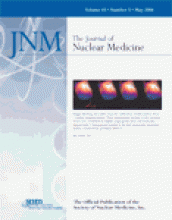TO THE EDITOR:
We read the article by Donohoe et al. with great interest and appreciation that the Society would attempt some standardization for brain death in the Journal of Nuclear Medicine (1). There is, however, some valuable information that should accompany this procedure guideline. It is vital for interpreting physicians to understand that the results must completely meet the strict criteria for whole-brain death. This is important for the protection of both the patient and the physician.
To meet the criteria for whole-brain death, perfusion must be absent from the whole brain, both cerebrum and cerebellum (2). Without the use of persistent agents, accurate evaluation of brain perfusion is not possible (2). Spieth et al. state, “Unlike DTPA (technetium 99m-diethylene-triaminepentaacetic), HMPAO (technetium 99m-hexamethylpropylene amine oxime) normally visualizes the gray matter of the cerebellum, midbrain, and medulla. These areas must be evaluated to meet the strict criteria for brain death.” (3). These findings suggest that persistent agents are a better choice for cerebral perfusion studies to determine brain death (3). Spieth et al. explain, “Although HMPAO is more expensive than DTPA, it is less expensive than the total cost of a repeat study using DTPA. A single HMPAO dosage can be re-imaged should there be equipment or other technical failures during acquisition.” (3). At that time, HMPAO was the only available technetium-labeled agent able to meet the strict criteria for the clinical confirmation of whole-brain death (3). Neurolite (Bristol-Myers Squibb Medical Imaging, Inc.) is another persistent agent available since the above articles were written.
REPLY:
The authors of the recently published “Procedure Guideline for Brain Death Scintigraphy” (1) would like to thank Drs. Spieth, Devadas, and Gauger for their comments. Indeed, the point they raise was one of the more difficult issues to address during the writing of the guideline. Several authors of the guideline believed, for similar reasons to those stated by the authors of the letter, that hexamethylpropyleneamine oxime and ethylcysteinate dimer were the preferred agents to use for the diagnosis of brain death. However, other guideline authors believed that limiting the diagnosis of brain death to brain-specific agents alone was too restrictive, particularly in light of the long track record of success with the nonspecific perfusion agents.
We looked to the literature for guidance and found no convincing evidence comparing the specific and nonspecific perfusion agents. The articles cited by Spieth et. al. in Clinical Nuclear Medicine are interesting, but they did not demonstrate the superiority of one agent over another and did not provide evidence that the ultimate patient outcome was affected differently by one agent compared with the other. We believed that before we dismiss the usefulness of the nonspecific perfusion agents, more evidence needs to be published.
Our final decision was to present the 2 alternatives and discuss the relative advantages and disadvantages of each, allowing the readers of the guideline to choose that with which they were most comfortable.
We encourage readers of all the procedure guidelines to forward any comments to the Guideline and Communications Committee. All procedure guidelines are available for download from the Society of Nuclear Medicine Web site at http://interactive.snm.org/index.cfm?PageID=772. Comments on any of the guidelines are encouraged and should be sent to Matt Cross at mcross{at}snm.org. The guidelines are frequently updated, and with each review cycle, all comments offered on each guideline are considered.







